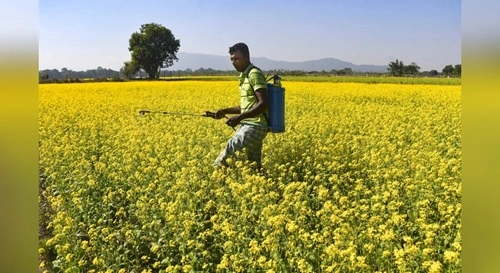Mustard is one of the most important edible oilseeds in India, used for oil, crop rotation, supports rural livelihood, and much more. During the Rabi season 2024-25, industry surveys and government reports indicate that India’s mustard production expanded to approximately 92.15 lakh hectares.
The total mustard production is estimated to be about 115.2 lakh tonnes. Even though the acreage from the previous season is slightly lower, the production numbers are sustained. All this became possible through improvement in agricultural practices, favourable weather in key states, and local-level government schemes. The Solvent Extractors’ Association of India (SEA) and other satellite analytics have helped in delivering these estimates.
Many states did well in the mustard-rapeseed production, whereas some remain close in production competition. Let’s get started with the list of the top 5 highest mustard-producing states in India 2025 –

1. Rajasthan – Around 55.03 lakh tonnes
Rajasthan has been leading in mustard and rapeseed production for years, and it is still dominating in 2024-25 with its estimated cultivation area of about 34.74 lakh hectares. Rajasthan’s total production reached around 55.03 lakh tonnes, way above that of other states. Rajasthan alone contributes qual to the remaining four states in our list. The total yield rate came to about 1,497 kg per hectare, which is among the highest in major mustard-growing states. The districts that dominated heavily in mustard production are Alwar, Hanumangarh, Sriganganagar, and Bharatpur. The critical issues Rajasthan is dealing with during mustard and rapeseed production are temperature stress, input and procurement access, and moisture variation.
2. Uttar Pradesh – Around 15.60 lakh tonnes
Uttar Pradesh ranks second with 15.60 lakh tonnes of mustard and rapeseed production during the Rabi season of 2024-25. It has around 14.23 lakh hectares under mustard cultivation, which offered a yield rate of around 1,096 kg per hectare, significantly lower than in Rajasthan. The key districts that contributed to mustard and rapeseed production are Agra, Aligarh, Etawah, Farrukhabad, and Kanpur. The mustard crop here is mostly used for oil, seeds, culinary, and spice uses. For now, the major issues Uttar Pradesh is dealing with during mustard production are sowing delays, pests, and quality variation with input.
3. Madhya Pradesh – Around 14.66 lakh tonnes
Madhya Pradesh cultivated around 14.86 lakh hectares of land for mustard farming in 2024-25. The total state output came out around 14.66 lakh tonnes with a total yield rate of 987kg per hectare. The number was a bit lower than in other states than of Rajasthan and Haryana. However, these numbers matter for a state’s economy, domestic demand, and farmers’ livelihood. The key states that dominate in mustard production are Morena, Gwalior, Sheopur, and the northern belt. The current issue MP is facing with mustard production are weather anomalies, constraints in accessing high-quality input, and mustard quality variation.
4. Haryana – Around 12.30 lakh tonnes
Haryana is always in the top five for mustard production, and the same is in 2024-25. Even with lower acreage than many other states, Haryana’s mustard and rapeseed yield rate came around 1,723 Kg per hectare, which means the production came around 12.30 Lakh Tonnes. This number becomes possible through 7.14 lakh Hecate under mustard cultivation. The key districts that dominated in the mustard crop production are Hisar, Fatehabad, Bhiwani, Sirsa, and Parts of Kaithal.
5. West Bengal – Around 6.79 lakh tonnes
Even though West Bengal has small farms and deals with climate variability, it still managed to hold fifth position in mustard production. In 2024-25, West Bengal has produced around 6.79 lakh tonnes of mustard with 6.83 lakh hectares under cultivation. The yield rate came around 994.78 kg per hectare, lower than in other states. The regions that produced the highest mustard are Malda, Murshidabad, and nearby areas. Mustard in West Bengal is used for oil, seeds, and local culinary uses (mustard oil being popular in East Indian cooking). It also supplies seed markets and regional oil mills.
Conclusion
India’s mustard production in 2024-25 came to about 115 lakh tonnes, and these five states have contributed the major part of it. The total contribution of these five states alone was around 100 lakh tonnes out of 115 lakh tonnes of the national output.